Here’s Exhibit A why you don’t use an extension cord to plug in your RV.
The other day, I arrived at a service call where the customer had complained about the appliances throwing error codes, the ceiling lights dimming, and low-voltage loads generally not working. These are all classic signs of low system voltage, where the DC side of the RV’s electrical system has fallen below 12 volts.
>>> READ MORE: RV 101: The Electrical System
Unfortunately, when I arrived, not only did I discover a buzzing, burnt out WFCO converter and two dead house batteries with a barely detectable heart rate of 2.15 volts, but I aso discovered that the travel trailer was plugged into a 50-ft RV power cord … plus another 50-ft RV power cord … plus a 100-ft household extension cord … into an accessory outlet built into the base of a ceiling lamp.
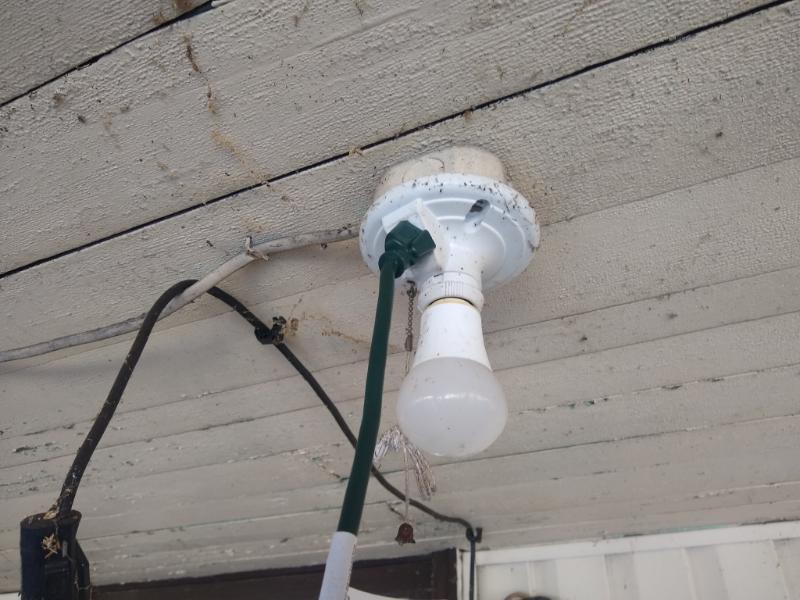
Before I continue, let me say that the RV owner was a wonderful, intelligent, and resourceful person. This post is not any kind of personal criticism. Knowledge of electricity is not conferred at birth, and this story just goes to show how even the educated among us can easily put ourselves at risk of fire and electrocution if we don’t play by the rules of physics that God laid down.
Here’s How to Use an Extension Cord to Power Your RV:
If you’re pressed for time and unable to complete this riveting, compelling article, here are the six facts you should know about using an extension cord with your RV:
- If possible, don’t use any extension cords at all! Use a single, unbroken, listed RV power cord with a minimum of adapters and dogbones.
- Choose the shortest cord necessary. Some RVers travel with 25, 50, and 100-ft cords for this very reason.
- All extension and power cords must have a ground wire.
- If you must use an extension cord, choose minimum 10-gauge wire for a 30-amp hookup or minimum 6-gauge wire for a 50-amp hookup.
- Protect all outdoor plug-in connections as best as you can. Enclose plugs inside weatherproof boxes.
- Double-check the quality and safety of the receptacle you’re plugging into! Many homes (and some campgrounds) are wired improperly and may not protect your shore power cords.
- Use an advanced “EMS” surge protector to verify the quality and safety of your power source. It’s cheap insurance!
Example of the WRONG Way to Use Extension Cords for an RV:
To recap, the RV power hookup went from this 30-amp 120-volt power inlet cord:

To this 50-ft RV power cord with unprotected plug:
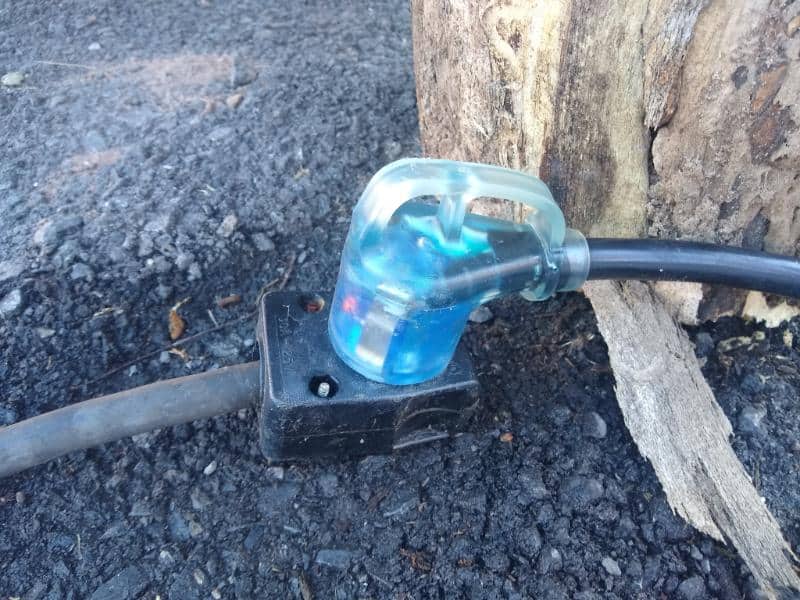
To another 50-ft RV power cord with an unprotected plug … to a 100-ft household extension cord (16- or 14-gauge wire) with another unprotected plug:
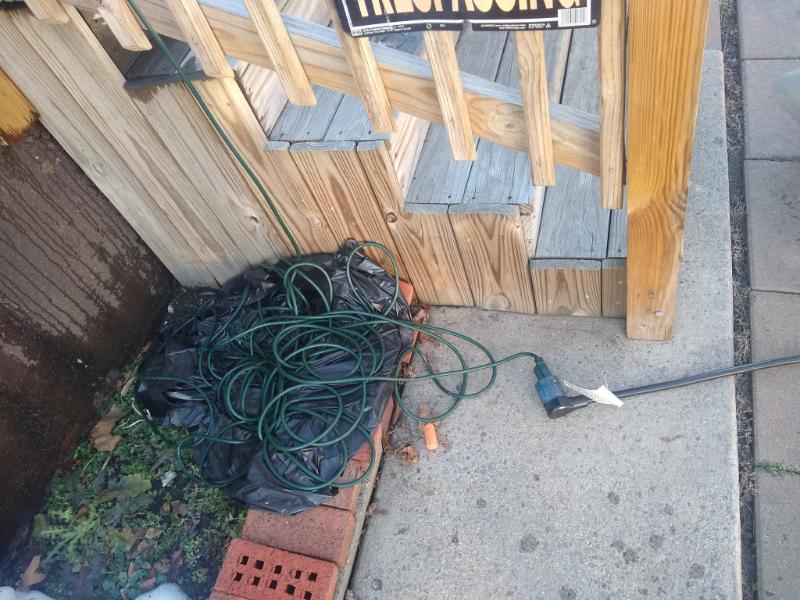
To an accessory outlet built into the base of a ceiling luminaire:

What could go wrong, you say? Why shouldn’t you plug in your RV using a household extension cord? Well, let’s begin!
Using an Extension Cord to Plug In an RV Will Drop Voltage
Voltage can be thought of as the electrical pressure that pushes current to flow. As voltage drops, electricity “loses pressure,” and it can’t do the work it’s supposed to.
Everything will lose some voltage when current passes through it. But conductors, like copper and aluminum, generally lose very little. That’s a big reason why your RV (and your house, for that matter) is wired with copper wire –
– but there’s a catch. The wire must be large enough for the working current to pass through it without excessive resistance. If the wire is too small, it acts like a constriction in a pipe, forcing the electrical current to “slow down” and lose “pressure.” This lost energy is dissipated as heat, which is critical to remember.
I know household extension cords look like plenty-fat cables, but that’s just because there are three (sometimes four) insulated wires bundled inside a thick plastic jacket. In reality, most household extension cords use pretty thin wire: 16-gauge or 14-gauge wire, which are normally rated for 10 amps or 15 amps, respectively. (We’ll talk more about that in a minute.)

These wires are too small for the current draw of an RV – in this customer’s case, up to 30 amps! They also induce a voltage drop, which can cause all kinds of problems in an RV: absorption refrigerators won’t cool very well, air conditioner compressors will burn out, microwaves can break down, etc. Not a good situation, and one that can quickly become very expensive.
When I measured AC voltage at the panelboard, I registered just 96 volts (eek!). When I unplugged the failing converter, voltage bounced up to 112 volts. If you know your voltages, you know that the U.S. standard is normally 120 volts (and 125 is becoming more common). When I measured AC voltage at the house outlet, I registered 123.5 volts, so the source voltage was good – all those power cords, extension cords, and connections were losing lots of voltage along the way!
To put this into perspective, anything below 115 volts is usually lower than what the appliance was designed for, and anything below 108 volts can damage inductive loads, like compressors and motors. 96 volts is way, way too low, and I was surprised that many AC appliances were still “properly” operating.
- Solution: Get rid of the household extension cord! Use listed RV power cords only. If you must use an extension cord, go buy a heavy-duty contractor-grade extension cord with 10-gauge wiring for 30-amp service or 6-gauge wiring for 50-amp service – and those are just the minimum sizes.
Small Wires Are a Fire Hazard
Let’s return to something I wrote a few paragraphs ago:
“In reality, most household extension cords are 16-gauge or 14-gauge wire, which are normally rated for 10 amps or 15 amps, respectively.”
This is incredibly important. All the wiring in the RV is protected by the RV’s master circuit breaker, which is either a 30-amp single-pole breaker or a 50-amp double-pole breaker. In this case, it was a 30-amp breaker. But the shore power cord is protected by the upstream circuit breaker, either in the house’s or campground’s panel board.
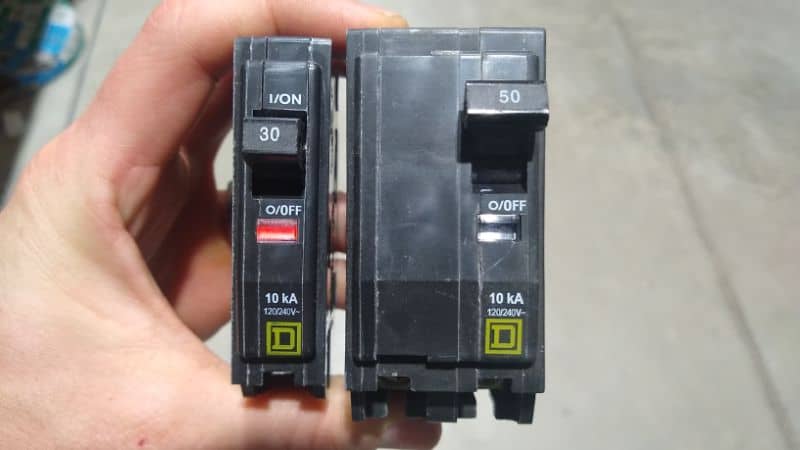
16-gauge wire is too small for a standard 15- or 20-amp circuit breaker. It’s not safe. It’s a fire hazard. The wires can overheat and melt the plastic insulation, which can cause arcing, ground faults, and other safety hazards.
If you don’t believe me, watch this video from Mike Sokol showing what happens to a 14-gauge extension cord when it’s asked to handle 30 amps. The extension cord can get so hot you can’t handle it without burning your skin!
Household extension cords are only allowed to be made this small because of the concept of derating; they were never intended to be used as a semi-permanent power distribution branch circuit!
- Solution: Get rid of the skinny household extension cord! Trust a cord with the correct size of wiring: minimum 10-gauge for 30-amp, minimum 6-gauge for 50-amp. RV power cords were made for this purpose! Plus, the bigger contacts are better suited for continuous high current draw.
Multiple Extension Cords Have Multiple Failure Points
Let’s go back to another thing I wrote:
I aso discovered that the RV was plugged into a 50-ft RV power cord … plus another 50-ft RV power cord … plus a 100-ft household extension cord … into an auxiliary outlet built into the base of a ceiling lamp.
The quality and safety of a wiring circuit is only as good as its connections and terminations. The best power cord in the world won’t save you from a corroded or loose plug.
Let’s use the correct language when we talk about these connections. NEMA uses certain specific terms:
- Receptacle – A female wiring device, usually flange-mounted, which serves as an outlet. When nothing is plugged into it, the hidden contacts are usually live.
- Plug – A male wiring device mostly mounted on a cord. Unlike the receptacle, the contacts (pins) of a plug protrude outward. Therefore, it is never live when not in use.
- Connector – A female wiring device mostly mounted on a cord. Like the receptacle, the conducting parts of the connector, inside the slots, are also hidden. It is also live even when idle.
- Inlet – A box-mounted wiring device with exposed, extended conductive contacts. Like the plug, the contacts are dead when the mating device is out of use.
With this RV, many of the connections between power cords were simply left outside, exposed to the rain and the snow. These connections are certainly not watertight. Water will work its way inside and will cause the prongs and slots to corrode (yes, almost all metals can corrode).
A corroded contact will lose voltage. Over time, the connection can become loose, which causes arcing and pitting. Corroded contacts can also cause Open Ground and Open Neutral conditions, both of which induce some pretty weird, pretty dangerous electrical problems in RVs.
In fact, I removed the green extension cord from the accessory outlet just to check the prongs, because I suspected there was no way that connection was secure. Sure enough, I could see where the contacts were beginning to burn:
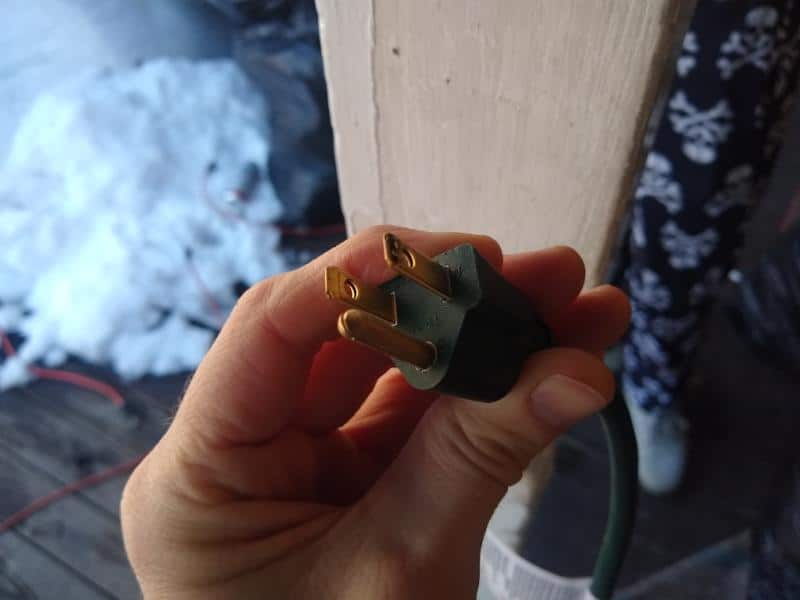
- Solution: It’s best to use a single shore power cord to hook up. Multiple cords introduce multiple points of failure. They do make 50- and 100-ft RV power cords with 10-gauge or 6-gauge wiring, which are far safer and will lose far less voltage. As of this writing, a 100-ft 30-amp RV power cord costs about $210.
An RV Shore Power Plug Is Only As Good as Its Source
Now let’s talk about that accessory outlet, the one built into the base of the ceiling luminaire.
Where do we start? With the fact that the cord is hanging down and trying to unplug itself, or that the cord can be easily tripped over? With the fact that a luminaire outlet is made cheap, and it’s not robust enough to be used long-term? With the fact that this particular luminaire was added on by a previous homeowner who may (or may not) have tapped into any available circuit, including one that was NOT rated for the correct amperage!
In fact, the RV owner told me they switched outlets because they were originally plugged into an outlet in the basement, which kept tripping the house’s circuit breaker. So they plugged into this one instead. Now, no tripping. Unfortunately, that makes me think that this luminaire was added to a circuit with a breaker larger than 15 amps, and therefore the DIY branch wiring (and now the RV!!) is unprotected. This is what electricians call “bootleg wiring.”
- But I digress. Point being, the quality of your outlet matters, because not all electrical connections are equal. You could spend $75 on a high-quality, 50-amp RV receptacle, and it’d be worth every penny. Plugging into an accessory outlet that cost less than $1 to make is NOT a safe idea. It’s the same reason you don’t plug a space heater into a surge protector strip; it’s not made for that purpose!
Conclusion: An RV Power Cord Is Definitely Worth the Money

Yes, I know RV power cords are expensive. A 100-ft 50-amp RV shore power cord is more than $400! The smallest cord available, a 25-ft 30-amp version, is about $60. Either way, they cost a lot more than a household extension cord.
But as you’ve learned, the higher price exists for a good reason: your safety. Do yourself (and your air conditioner) a huge favor, and use the right cord for the job.
Leave a Reply